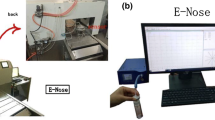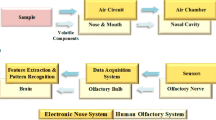Abstract
The food products may attract unscrupulous vendors to dilute it with inexpensive alternative food sources to achieve more profit. The risk of high value food adulteration with cheaper substitutes has reached an alarming stage in recent years. Commonly available detection methods for food adulteration are costly, time consuming and requires high degree of technical expertise. However, a rapid and suitable detection method for possible adulterant is being evolved to tackle the aforesaid issues. In recent years, electronic nose (e-nose) system is being evolved for falsification detection of food products with reliable and rapid way. E-nose has the ability to artificially perceive aroma and distinguish them. The use of chemometric analysis together with gas sensor arrays have shown to be a significant procedure for quality monitoring in food. E-nose techniques with numerous provisions are reliable and favourable for food industry in food fraud detection. In the present review, the contributions of gas sensor based e-nose system are discussed extensively with a view to ascertain the adulteration of food products.


Similar content being viewed by others
Abbreviations
- VOC:
-
Volatile organic compound
- SAW:
-
Surface acoustic wave
- MOS:
-
Metal oxide semiconductor
- PCA:
-
Principal component analysis
- PLS:
-
Partial least square
- SVM:
-
Support vector machine
- LDA:
-
Linear discriminant analysis
- PCR:
-
Principal component regression
- DFA:
-
Discriminant factor analysis
- ANN:
-
Artificial neural network
- PNN:
-
Probabilistic neural network
- BPNN:
-
Back propagation neural network
- SPME-MS:
-
Solid-phase microextraction mass spectrometry
References
Al-Maskari S, Li X, Liu Q (2014) An effective approach to handling noise and drift in electronic noses. In: Wang H, Sharaf MA (eds) Databases theory and applications. Lecture Notes in Computer Science, Springer, Cham, pp 223–230
Ayari F, Mirzaee-Ghaleh E, Rabbani H, Heidarbeigi K (2018a) Detection of the adulteration in pure cow ghee by electronic nose method (case study: sunflower oil and cow body fat). Int J Food Prop 21(1):1670–1679
Ayari F, Mirzaee-Ghaleh E, Rabbani H, Heidarbeigi K (2018b) Using an E-nose machine for detection the adulteration of margarine in cow ghee. J Food Process Eng 41(6):e12806
Banach U, Tiebe C, Hübert T (2012) Multigas sensors for the quality control of spice mixtures. Food Control 26(1):23–27
Bougrini M, Tahri K, Haddi Z, Saidi T, El Bari N, Bouchikhi B (2014) Detection of adulteration in argan oil by using an electronic nose and a voltammetric electronic tongue. J Sens 2014:1–10
Cerrato Oliveros MC, Pérez Pavón JL, Garcia Pinto C, Fernández Laespada ME, Moreno Cordero B, Forina M (2002) Electronic nose based on metal oxide semiconductor sensors as a fast alternative for the detection of adulteration of virgin olive oils. Anal Chim Acta 459:219–228
Clemente TE, Cahoon EB (2009) Soybean oil: genetic approaches for modification of functionality and total content. Plant Physiol 151:1030–1040
Deng Y (2019) Integration technologies in gas sensor application. Semiconducting Metal Oxides for Gas Sensing. Springer, Singapore, pp 175–193
Gan Z, Yang Y, Li J, Wen X, Zhu M, Jiang Y, Ni Y (2016) Using sensor and spectral analysis to classify botanical origin and determine adulteration of raw honey. J Food Eng 178:151–158
Gardner JW (1991) Detection of vapours and odours from a multisensor array using pattern recognition: principal component and cluster analysis. Sens Actuat 4:109–115
Gardner JW, Shurmer HV (1992) Odour discrimination with an electronic nose. Sens Actuat 8:1–11
Garrido-Delgado R, Muñoz-Pérez ME, Arce L (2018) Detection of adulteration in extra virgin olive oils by using UV-IMS and chemometric analysis. Food Control 85:292–299
Ghasemi-Varnamkhasti M, Mohammad-Razdari A, Yoosefian SH, Izadi Z, Rabiei G (2019) Selection of an optimized metal oxide semiconductor sensor (MOS) array for freshness characterization of strawberry in polymer packages using response surface method (RSM). Postharvest Biol and Tec 151:53–60
Gu DC, Liu W, Yan Y, Wei W, Gan JH, Lu Y, Jiang ZL, Wang XC, Xu CH (2019) A novel method for rapid quantitative evaluating formaldehyde in squid based on electronic nose. LWT 101:382–388
Hai Z, Wang J (2006a) Detection of adulteration in camellia seed oil and sesame oil using an electronic nose. Eur J Lipid Sci Tech 108(2):116–124
Hai Z, Wang J (2006b) Electronic nose and data analysis for detection of maize oil adulteration in sesame oil. Sensor Actuat B-Chem 119(2):449–455
Heidarbeigi K, Mohtasebi SS, Foroughirad A, Ghasemi-Varnamkhasti M, Rafiee S, Rezaei K (2015) Detection of adulteration in saffron samples using electronic nose. Int J Food Prop 8:1391–1401
Hong X, Wang J (2014) Detection of adulteration in cherry tomato juices based on electronic nose and tongue: Comparison of different data fusion approaches. J Food Eng 126:89–97
Hong EJ, Park SJ, Choi JY, Noh BS (2011) Discrimination of palm olein oil and palm stearin oil mixtures using a mass spectrometry based electronic nose. Food Sci Biotechnol 20(3):809–816
Hong X, Wang J, Qiu S (2014) Authenticating cherry tomato juices—discussion of different data standardization and fusion approaches based on electronic nose and tongue. Food Res Int 60:173–179
Jia W, Liang G, Jiang Z, Wang J (2019) Advances in electronic nose development for application to agricultural products. Food Anal Methods 12(10):2226–2240
Kauer JS (1991) Contributions of topography and parallel processing to odor coding in the vertebrate olfactory pathway. Trends neurosci 14(2):79–85
Kiani S, Minaei S, Ghasemi-Varnamkhasti M (2017) Integration of computer vision and electronic nose as non-destructive systems for saffron adulteration detection. Comput Electron Agric 141:46–53
Li J, Wang M, Liu Q, Zhang Y, Peng Z (2018) Validation of UPLC method on the determination of formaldehyde in smoked meat products. Int J Food Prop 21(1):1246–1256
Majcher MA, Kaczmarek A, Klensporf-Pawlik D, Pikul J, Jelen HH (2015) SPME-MS-based electronic nose as a tool for determination of authenticity of PDO cheese, Oscypek. Food Anal Methods 8:2211–2217
Man YC, Gan HL, NorAini I, Nazimah SAH, Tan CP (2005) Detection of lard adulteration in RBD palm olein using an electronic nose. Food Chem 90(4):829–835
Marina AM, Che Man YB, Amin I (2010) Use of the SAW sensor electronic nose for detecting the adulteration of virgin coconut oil with RBD palm kernel olein. J Am Oil Chem Soc 87(3):263–270
Men H, Chen D, Zhang X, Liu J, Ning K (2014) Data fusion of electronic nose and electronic tongue for detection of mixed edible-oil. J Sens 2014:1–7
Mildner-Szkudlarz S, Jeleń HH (2008) The potential of different techniques for volatile compounds analysis coupled with PCA for the detection of the adulteration of olive oil with hazelnut oil. Food Chem 110(3):751–761
Mildner-Szkudlarz S, Jeleń HH (2010) Detection of olive oil adulteration with rapeseed and sunflower oils using mos electronic nose and SMPE-MS. J Food Qual 33(1):21–41
Modupalli N, Naik M, Sunil CK, Natarajan V (2021) Emerging non-destructive methods for quality and safety monitoring of spices. Trends Food Sci Technol 108:133–147
Moosavy MH, Kordasht HK, Khatibi SA, Sohrabi H (2019) Assessment of the chemical adulteration and hygienic quality of raw cow milk in the northwest of Iran. Qual Assur Saf Crop 11(5):491–498
Nurjuliana M, Man YC, Hashim DM (2011) Analysis of lard’s aroma by an electronic nose for rapid halal authentication. J Am Oil Chem’ Soc 88(1):75–82
Ordukaya E, Karlik B (2016) Fruit juice–alcohol mixture analysis using machine learning and electronic nose. IEEJ Electr Electr 11:S171–S176
Pandey SK (2016) Prevailing practices of artificial ripening of mango, banana and papaya through calcium carbide in Jharkhand. Agric Eng Today 40(3):35–39
Peña F, Cardenas S, Gallego M, Valcárcel M (2005) Direct olive oil authentication: detection of adulteration of olive oil with hazelnut oil by direct coupling of headspace and mass spectrometry, and multivariate regression techniques. J Chromatogr A 1074(1–2):215–221
Peng Q, Tian R, Chen F, Li B, Gao H (2015) Discrimination of producing area of Chinese Tongshan kaoliang spirit using electronic nose sensing characteristics combined with the chemometrics methods. Food Chem 178:301–305
Penza M, Cassano G (2004) Recognition of adulteration of Italian wines by thin-film multisensor array and artificial neural networks. Anal Chim Acta 509(2):159–177
Persaud K, Dodd G (1982) Analysis of discrimination mechanisms in the mammalian olfactory system using a model nose. Nature 299(5881):352–355
Shen F, Wu Q, Su A, Tang P, Shao X, Liu B (2016) Detection of adulteration in freshly squeezed orange juice by electronic nose and infrared spectroscopy. Czech J Food Sci 34(3):224–232
Subari N, Mohamad Saleh J, Md Shakaff A, Zakaria A (2012) A hybrid sensing approach for pure and adulterated honey classification. Sensors 12(10):14022–14040
Subari N, Saleh JM, Shakaff AYM (2014) Fusion technique for honey purity estimation using artificial neural network. In: International conference on advances in intelligent systems in bioinformatics. Atlantis Press, pp 35–40
Tahri K, Tiebe C, El Bari N, Hübert T, Bouchikhi B (2017) Geographical classification and adulteration detection of cumin by using electronic sensing coupled to multivariate analysis. Procedia Technol 27:240–241
Tian X, Wang J, Ma Z, Li M, Wei Z (2019) Combination of an E-Nose and an E-Tongue for adulteration detection of minced mutton mixed with pork. J Food Qual 2019:1–10
Tohidi M, Ghasemi-Varnamkhasti M, Ghafarinia V, Bonyadian M, Mohtasebi SS (2018a) Development of a metal oxide semiconductor-based artificial nose as a fast, reliable and non-expensive analytical technique for aroma profiling of milk adulteration. Int Dairy J 77:38–46
Tohidi M, Ghasemi-Varnamkhasti M, Ghafarinia V, Mohtasebi SS, Bonyadian M (2018b) Identification of trace amounts of detergent powder in raw milk using a customized low-cost artificial olfactory system: a novel method. Measurement 124:120–129
Tsopelas F, Konstantopoulos D, Kakoulidou AT (2018) Voltammetric fingerprinting of oils and its combination with chemometrics for the detection of extra virgin olive oil adulteration. Anal Chim Acta 1015:8–19
Wang Q, Li L, Ding W, Zhang D, Wang J, Reed K, Zhang B (2019) Adulterant identification in mutton by electronic nose and gas chromatography-mass spectrometer. Food Control 98:431–438
Wei X, Shao X, Wei Y, Cheong L, Pan L, Tu K (2018) Rapid detection of adulterated peony seed oil by electronic nose. J Food Sci Technol 55(6):2152–2159
Yu H, Wang J, Xu Y (2007) Identification of adulterated milk using electronic nose. Sensor Mater 19:275–285
Zakaria A, Shakaff AYM, Masnan MJ, Ahmad MN, Adom AH, Jaafar MN, Ghani SA, Abdullah AH, Aziz AHA, Kamarudin LM, Subari N (2011) A biomimetic sensor for the classification of honeys of different floral origin and the detection of adulteration. Sensors 11(8):7799–7822
Author information
Authors and Affiliations
Contributions
MR implemented the idea, collected the literature, analysed the content, and wrote the manuscript; BKY conceived the idea, supervised the work and edited the manuscript.
Corresponding author
Ethics declarations
Conflict of interest
The authors declare that they have no conflict of interest.
Additional information
Publisher's Note
Springer Nature remains neutral with regard to jurisdictional claims in published maps and institutional affiliations.
Rights and permissions
About this article
Cite this article
Roy, M., Yadav, B.K. Electronic nose for detection of food adulteration: a review. J Food Sci Technol 59, 846–858 (2022). https://doi.org/10.1007/s13197-021-05057-w
Revised:
Accepted:
Published:
Issue Date:
DOI: https://doi.org/10.1007/s13197-021-05057-w




